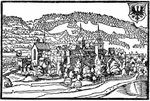The NOT-Minden French Flags Project is an extension of the Minden French Flags Project which allows me to do other French flags of the SYW, especially now I have done all the easier and less complicated flags of the French infantry at Minden, and, like today, feeling weary late on a Wednesday evening, want an easy flag to post to keep things ticking over...
And so back to Regiment Normandie:
First raised in 1574 as the Bandes de Normandie which were created from the Vieilles bandes françaises, this was one of the six Vieux Corps and had 4 battalions. The regiment was in garrison from 1757-1760 in Ostende and then various places in Artois. From 1760 it served with the army of Maréchal de Castrie; in October that year it was at the battle of Clostercamps where it initially distinguished itself but while in pursuit over open ground was counter-attacked by British cavalry and lost a flag. In 1761 it was at the battle of Vellinghausen but took no part in the action. At the end of that year it returned to France to guard the coast of Normandy.
The flags were as depicted from 1616 to 1791:
And this plate shows the uniform and flags in 1757:






























.png)























